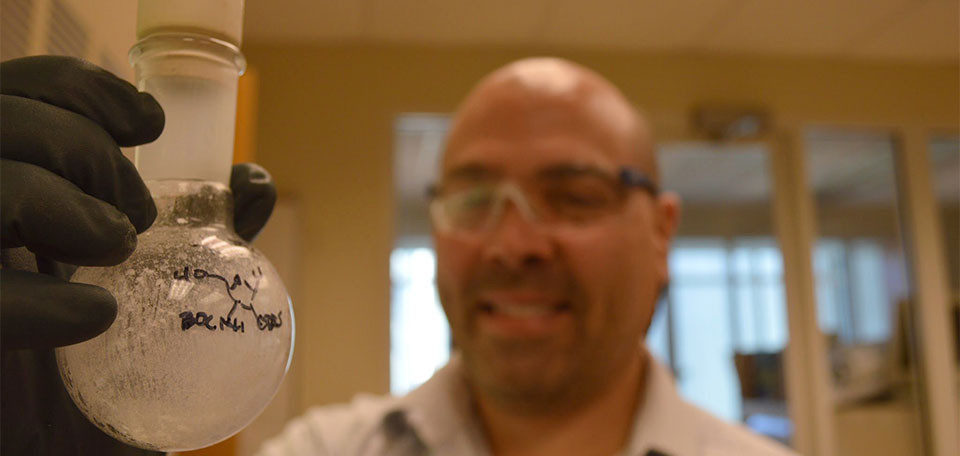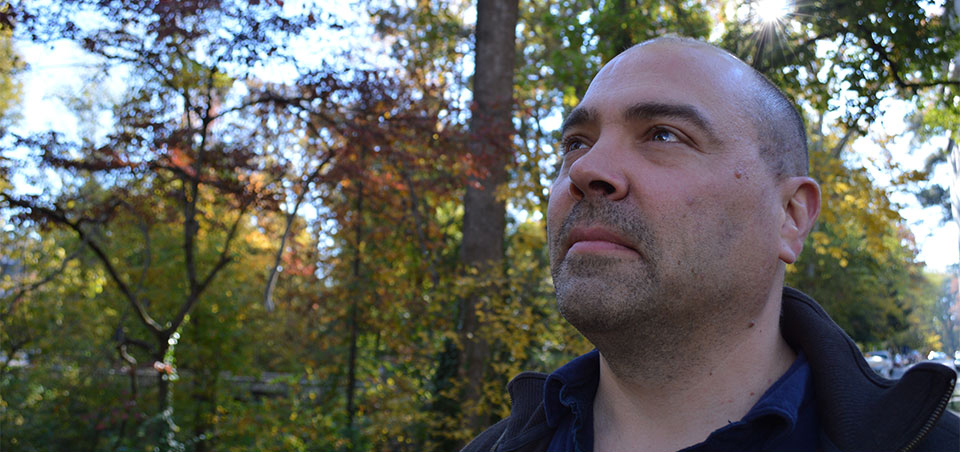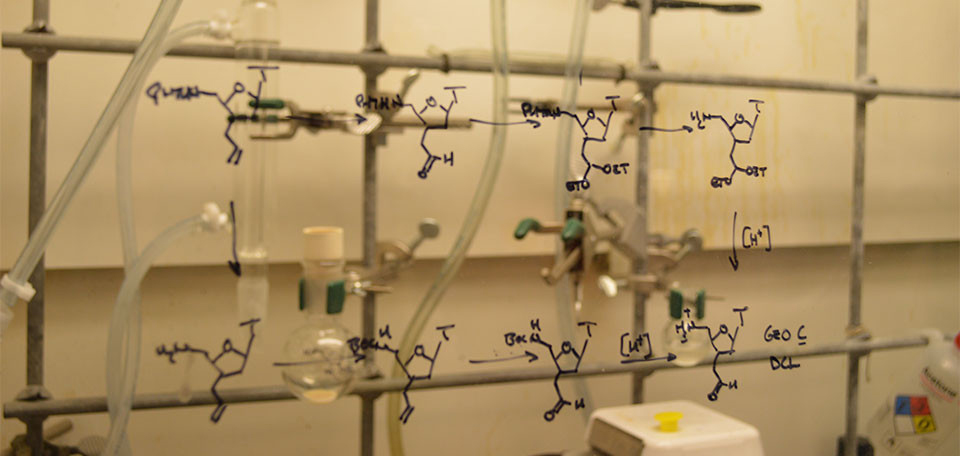Small Matters: Emergence
Air Date: Week of March 21, 2014

Jay Goodwin’s Chemistry routinely surprises him. (Ari Daniel)
Out of seemingly amorphous chaos comes order and pattern. That's the nature of Emergence, and you can see it in phenomena as diverse as flocks of birds and the structure of crystals. Ari Daniel reports.
Transcript
CURWOOD: From traffic patterns to patterns in nature, the universe is full of seemingly random things that somehow manage to organize themselves into complex, even beautiful patterns. Think of crystals, or frost on a window. And it's that emergence of order from chaos that Ari Daniel describes in this week's episode in the occasional series, Small Matters.
DANIEL: Once in a while, if you’re lucky, you catch a glimpse of something that gives away a secret of the universe. It’s like a window – up into the heavens and deep into ourselves. This is a story is about someone who poked his head through just this kind of window, and we find him in Atlanta.
It’s a perfect day here – Jay Goodwin walks over to a bench to sit down. And he can’t help but be reminded about a day just like this one, 5 years ago, in western Michigan where he used to live.

Several years ago a chance encounter in the sky stopped Jay Goodwin in his tracks. (Ari Daniel)
GOODWIN: I was outside – I think I was going for a walk, just to kind of clear my head a little bit. I turned a corner, and I saw this flock of birds and they took off into the sky and they started to form a shape – sort of an amorphous shape. And it was one that was dynamic, and it was changing – but it had a boundary to it, like looking at a blob of oil in water.
DANIEL: It stopped Goodwin in his tracks. Several hundred birds pulsing and dipping and soaring to an invisible beat in the sky.
GOODWIN: It wasn’t clear what they were responding to – there weren’t any predator birds in the sky. And you never got the sense that there was anything that was directing it from within. There was no leader bird that they were all following. But just watching it was, well, it was beautiful.
DANIEL: Goodwin realized he had no way of predicting the flock’s behavior by simply taking lots of individual birds flapping their wings, and adding them up. Rather, it was something that emerged once all these birds threw themselves together. And it’s this notion of emergence – how really complex patterns and properties can arise from combining somewhat simple units – that now defines how Goodwin thinks about his real work. Chemistry.
Goodwin heads into his lab at Emory University. He’s a chemist here. And since seeing that flock, he’s come to appreciate how molecules are a lot like birds. That is – you get to know how the individuals behave and parade on their own, but then, you put them together. And often, something new and astonishing emerges.
GOODWIN: We always want to allow some room for serendipity – and allowing the molecules themselves to show us what they’re capable of doing.

It’s not easy to predict what will happen when you bring molecules together. (Ari Daniel)
DANIEL: Let’s take an example. A glass of water.
GOODWIN: Water molecules in the liquid form are tumbling past each other, and they see each other very dynamically, very quickly, and they move on.
DANIEL: Now cool that water down. The movement of the water molecules begins to slow, and they spend more time kind of looking at each other.
GOODWIN: And they begin to align with each other, and become solid. And they grab more water molecules out of solution as they slow down, and that process begins to propagate and to grow until the whole thing is one big lattice of solid ice.
DANIEL: And the thing about ice – it floats on water. We take that for granted, but most solids sink to the bottom of their liquid form because they’re more dense. Not water. It floats – which is crucial for life.
GOODWIN: Underneath ice in a lake or an ocean or the Arctic is liquid water. That’s one of the unique features of water. That’s an emergent property.
DANIEL: Emergent, because it’s just what happens when you throw a bunch of water molecules together, and cool them down.
Now, Goodwin doesn’t study water. He’s curious about other things, like how, in the brains of people with Alzheimer’s, a single misshapen protein can trigger neighboring proteins to buckle and warp, until a tangled plaque has emerged. Like an errant bird reshaping its entire flock. Goodwin also studies what might have happened on the Earth a few billion years ago – trying to learn the rules of how simple molecules might’ve assembled to lead to the emergence of life. Emergence, it turns out, is everywhere.
GOLDBART: There’s no particular reason why emergence should be a property that happens at the scale of atoms and molecules, but not at the scale of let’s say viruses, or even galaxies for that matter.
DANIEL: Paul Goldbart is a physicist at Georgia Tech who studies how the building blocks of matter interact to form the very small, the very big, and everything in between. He says it’s like watching a dance – knowing that the whole isn’t just greater than the sum of the parts – it’s wondrously different.
GOLDBART: We marvel at the way matter organizes. Not only do we get to see beauty and organization and patterns, but also they’re useful to better society and provide services and materials that make our lives safer and more vibrant.
DANIEL: Back in the lab, this is exactly what Jay Goodwin is doing. Harnessing the idea of emergence, by putting molecules together and watching what happens, by creating room for his chemistry to surprise him – and then, turning those insights to use.
GOODWIN: To understanding disease and how to solve disease, and how to develop new therapeutics, and how to diagnose disease and how to create new materials that could be intelligent, that could respond to their environments in different ways – could be self-?? healing, could capture solar energy for instance.
DANIEL: Goodwin’s aim has become one of taking advantage of the rules that determine how molecules behave. Rules that are somewhat mysterious, and can emerge when you take the time to appreciate that they’re there.
For Living on Earth I’m Ari Daniel.
CURWOOD: Our series, Small Matters, is produced by the Center for Chemical Evolution, with support from the National Science Foundation and NASA.
Links
Living on Earth wants to hear from you!
Living on Earth
62 Calef Highway, Suite 212
Lee, NH 03861
Telephone: 617-287-4121
E-mail: comments@loe.org
Newsletter [Click here]
Donate to Living on Earth!
Living on Earth is an independent media program and relies entirely on contributions from listeners and institutions supporting public service. Please donate now to preserve an independent environmental voice.
NewsletterLiving on Earth offers a weekly delivery of the show's rundown to your mailbox. Sign up for our newsletter today!
 Sailors For The Sea: Be the change you want to sea.
Sailors For The Sea: Be the change you want to sea.
 The Grantham Foundation for the Protection of the Environment: Committed to protecting and improving the health of the global environment.
The Grantham Foundation for the Protection of the Environment: Committed to protecting and improving the health of the global environment.
 Contribute to Living on Earth and receive, as our gift to you, an archival print of one of Mark Seth Lender's extraordinary wildlife photographs. Follow the link to see Mark's current collection of photographs.
Contribute to Living on Earth and receive, as our gift to you, an archival print of one of Mark Seth Lender's extraordinary wildlife photographs. Follow the link to see Mark's current collection of photographs.
 Buy a signed copy of Mark Seth Lender's book Smeagull the Seagull & support Living on Earth
Buy a signed copy of Mark Seth Lender's book Smeagull the Seagull & support Living on Earth

